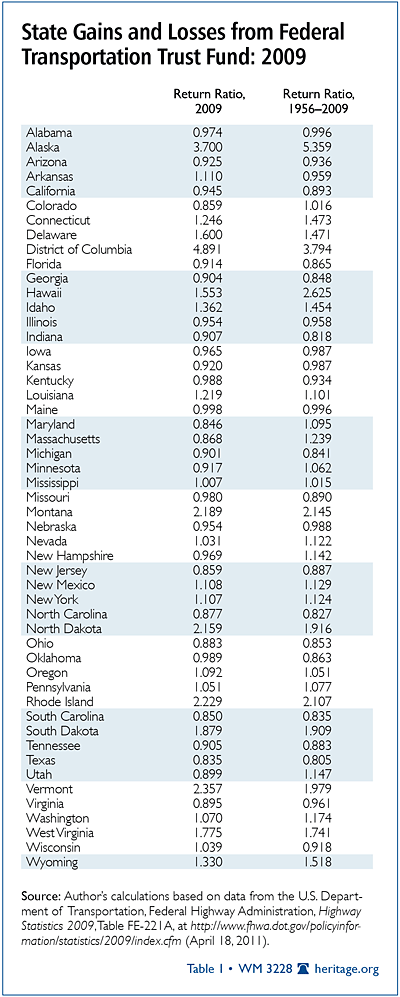Under the laws governing the federal highway program, the federal fuel taxes paid into the trust fund by motorists (18.3 cents per gallon) and truckers are returned to the states by a series of mathematical formulas that attempt to match the scope and usage of each state’s surface transportation system with payments received from the trust fund.[1] These formulas, however, embody a number of serious flaws that cause many states (called donors) to consistently receive shares that are less than they pay in, while others (called donees) consistently receive more.
Pervasive Inequities in the System
This deficiency in calculation exacerbates regional transportation problems. The shortchanged states are typically those with above-average population growth whose transportation needs exceed those of the slower-growing states, which often receive shares greater than what they pay in. While half-hearted efforts have been made in the past to mitigate this problem, little real progress has been made, and the depletion of the trust fund in fiscal year (FY) 2008 further complicates efforts to address these pervasive inequities. In FY 2009 (the most recent fiscal year for which data are available), 28 states were donor states, receiving a smaller share of money from the trust fund than they paid into it.
Over the past several decades, states shortchanged by the program have been concentrated in the Southeast and the Great Lakes region, as well as California and Arizona. The states receiving more than their fair share have been concentrated in the Northeast and Middle Atlantic states and the sparsely populated Mountain states. States with a share ratio less than 1.0 are donors and are receiving a smaller share back compared to what they pay in. Those whose share ratio exceeds 1.0 are getting back more than the share of taxes they contribute to the trust fund.

In 2009, there were 28 donor states and 22 donee states, although many states were close to being even in their return ratios. In 2009, for example, Texas received only an 83.5 percent payback, costing it $672 million in underpayments that year. Also in 2009, Florida received just 86 percent back, Arizona received 92 percent, and South Carolina received 85 percent. Many of the losing states in 2009 have been consistent losers since 1956. Tabulating return ratios over the past 53 years reveals that, among some of the 24 long-term losers, Texas received just 80.5 percent, Oklahoma received 86.3 percent, and Georgia received 85 percent.
Getting the Data Right
One reason for the persistence of these equity problems is that the U.S. Department of Transportation does not accurately calculate and report state-by-state equity shares and instead measures each state’s share by comparing the sum of dollars paid in to the sum of dollars paid out. Because the trust fund in recent years has paid out more than it receives in taxes and is now subsidized by general revenues, this way of measuring equity implies that all states earn an above-average return on their payments into the fund. This, of course, is a mathematical impossibility.
This reporting flaw was corrected by the Bush Administration, and accurate numbers were reported for 2007. But the new Obama team has reverted to the incorrect equity calculations and did not report the correct ones when the 2008 and 2009 data were released.
Under the correct methodology of share-return ratio calculations used here (and briefly adopted by the Federal Highway Administration in its 2007 report), Texas experienced an 83.5 percent return ratio in 2009, reflecting the fact that its tax revenues accounted for 9.616 percent of the money flowing into the fund, compared to the 8.031 percent of trust fund spending it received (8.031 is about 83.5 percent of 9.616).
Future Prospects
The current laws governing the federal highway and transit programs expired in September 2009 but have been extended repeatedly and are now set to expire in September 2011, thereby allowing more time to develop replacement legislation. To date, only the White House has offered a compromise plan for reauthorization, albeit one that is exceptionally costly and focuses its financial support and new programs on transportation modes that are consistently rejected by the traveling public.[2] Despite its 48 pages, the President’s plan is silent on the equity issue.[3]
Although a formal “turnback” plan[4] similar to the one supported by then-Representative John Kasich (R–OH) and Senator Connie Mack (R–FL) in the mid-1990s has not yet been introduced, Representatives Jeff Flake (R–AZ) and Scott Garrett (R–NJ) have introduced bills that address the problem. Flake’s bill is the Highway Fairness and Reform Act of 2011 (H.R. 632), and Garrett’s is the Surface Transportation and Taxation Equity Act (H.R. 3595).
While much remains to be done in completing a new highway reauthorization bill, the 28 donor states should begin to work together to seek an end to the inequities embodied in current law.
Ronald D. Utt, Ph.D., is Herbert and Joyce Morgan Senior Research Fellow in the Thomas A. Roe Institute for Economic Policy Studies at The Heritage Foundation.



